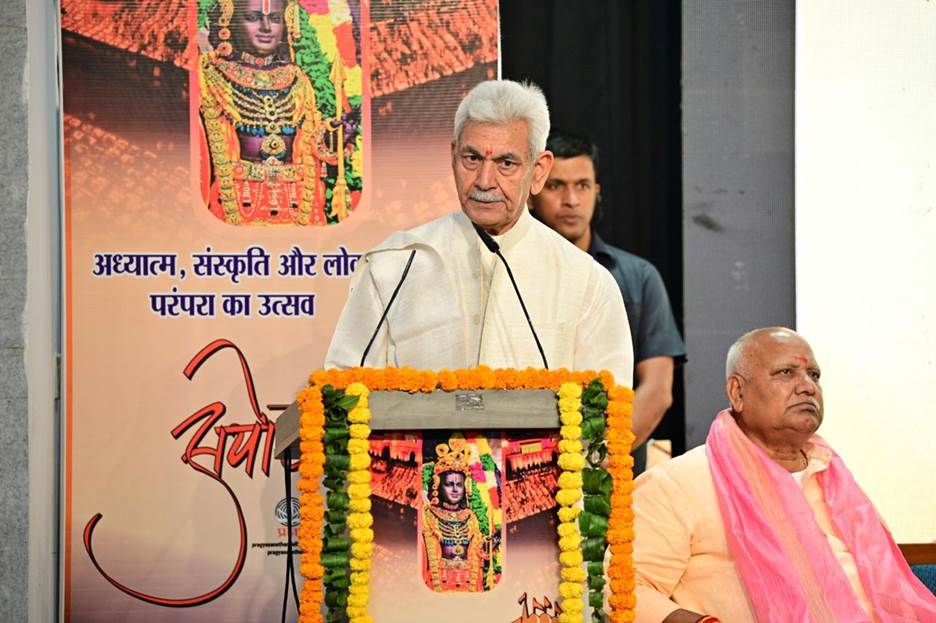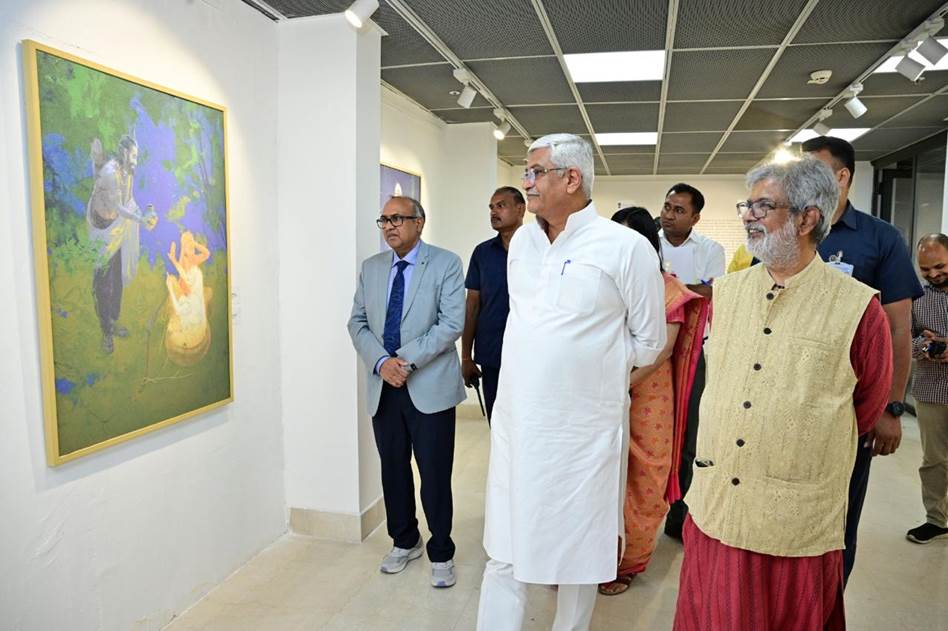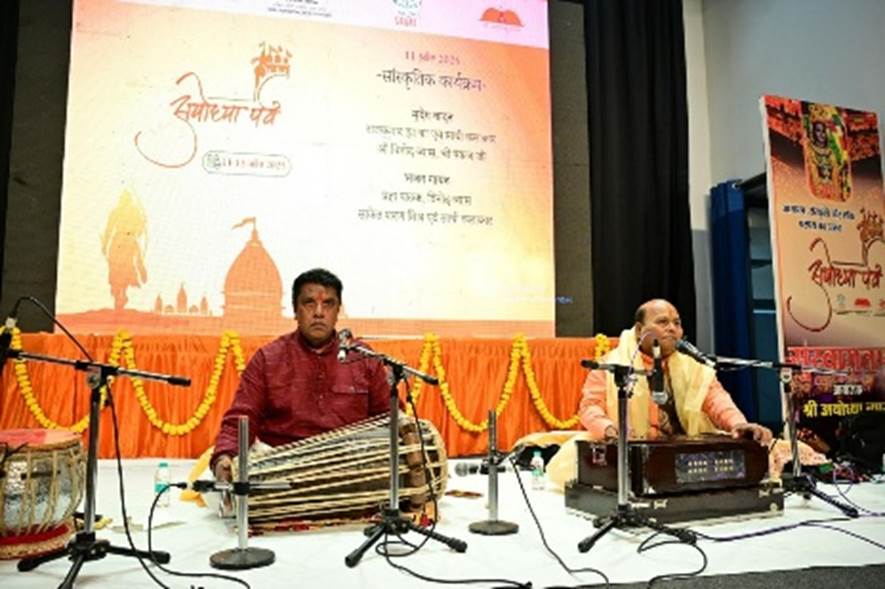Ministry of Culture
Character of Lord Rama has provided the Energy and Direction to sustain the flow of Indian Culture: Shri Gajendra Singh Shekhawat
Ayodhya was Ancient India’s Soft Power: Shri Manoj Sinha, Lieutenant Governor, Jammu & Kashmir
Three-day cultural celebration ‘Ayodhya Parv’ commenced with grandeur at IGNCA
Posted On:
11 APR 2025 10:30PM by PIB Delhi
The three-day cultural celebration ‘Ayodhya Parv’ commenced with grandeur at the Indira Gandhi National Centre for the Arts (IGNCA), marked by the inauguration of three remarkable exhibitions—one featuring Padma Shri Vasudev Kamath’s paintings based on 'Maryada Purushottam' (Lord Ram), a display of Pahari miniature paintings based on the 'Valmiki Ramayana', and a thematic exhibition titled 'Badi Hai Ayodhya' that portrays the pilgrimage landscape of Chaurasi Kos Ayodhya.

The exhibitions were jointly inaugurated by the revered Mahant Pujya Kamal Nayan Das Ji Maharaj of Mani Ram Das Chhawani, Ayodhya; Geeta Manishi Mahamandaleshwar Pujya Gyananand Ji Maharaj; Shri Manoj Sinha, Lieutenant Governor of Jammu & Kashmir; Shri Ram Bahadur Rai, President of IGNCA; and IGNCA Trustee and artist Shri Vasudev Kamath. Following the inauguration, each dignitary shared their reflections on the spiritual and cultural eminence of Lord Ram and Ayodhya. Three books were also released during the inaugural session. Union Minister of Culture and Tourism Shri Gajendra Singh Shekhawat visited and viewed the exhibitions on the occasion.

On this occasion, Shri Gajendra Singh Shekhawat extended his congratulations to IGNCA and the Ayodhya Nyas for organising the ‘Ayodhya Parv’ and wished the event great success. He remarked that the character of Lord Rama has not only inspired Indian thought and individuals working across diverse fields, but has also provided the energy and direction necessary to sustain the continuous flow of Indian culture. He noted that during the most difficult period of cultural invasion by foreign aggressors, Goswami Tulsidas composed the 'Ramcharitmanas' in the language of the common people, connecting with the collective consciousness of ordinary individuals. This, he said, made a significant contribution to preserving the essence of Sanatan culture. Since the reinstallation of the Ram Mandir and the return of Ram Lalla to Ayodhya Dham, it appears as though the sun of India's destiny has begun to rise once again.

The cultural proceedings commenced with an enthralling Mridang performance by Rajkumar Jha and his fellow artists Vinod Vyas and Shri Pankaj. This was followed by devotional renditions by Pragya Pathak, Vinod Vyas, Saket Sharan Mishra, and accompanying vocalists, which captivated the audience.
Speaking about the inauguration of the newly reconstructed Shri Ram Janmabhoomi temple on 22 January, Shri Manoj Sinha remarked, “I view 22 January not merely as a date but as a bridge that connects the past to the present in a significant manner.” He added, “This is not just the revival of an ancient city and pilgrimage site, but a spiritual awakening experienced by India across centuries. I believe the significance of Ayodhya transcends geography—it is the key to joy and awakening, the symbol of our cultural unity, and a guiding spiritual force. Ayodhya has long served as a cultural and spiritual foundation of our nation.”
Addressing the youth, he noted, “Ayodhya offers not only a spiritual pinnacle but also clearly embodies the values and aspirations of the individual. Lord Ram, in the context of Ram Rajya, is viewed as an embodiment of development, courage, justice, and a living dharma. Though he appeared in the Treta Yuga, he remains a visionary figure of good governance.” Shri Sinha further noted that India today runs the world's largest social security programme.
Earlier, IGNCA President Shri Ram Bahadur Rai outlined the structure of the Ayodhya Parv and remarked that the message of Ayodhya is increasingly being preserved through books and journals. Referring to the released book 'Chaurasi Kos ka Ayodhya', he said, “While physical Ayodhya may be defined by 84 kos, the spiritual Ayodhya is infinite, like the sky.” Geeta Manishi Pujya Gyananand Ji stated that India is a land of traditions, and festivals hold a special place in these traditions. “India is not merely a geographic entity—it is a philosophy, a thought,” he said. Pujya Mahant Kamal Nayan Das Ji questioned, “In which verse of the Vedas is untouchability or discrimination mentioned?” He emphasised that knowledge cannot be complete without social harmony. The inaugural session concluded with a vote of thanks by former Faizabad MP Shri Lallu Singh.
Notably, the Ayodhya Parv, dedicated to the splendour of Indian culture, art, and devotion centred around Ayodhya, will continue for two more days, featuring a range of dialogues and cultural presentations. This three-day cultural festival is envisioned as a confluence of reverence, classicism, and discourse, bringing together saints, cultural thinkers, political leaders, scholars, and artists from across the country.
On the second day, 12 April, at 11 a.m., a seminar titled 'Temple Management in Indian Society' will be held, featuring prominent saints from Ayodhya along with administrative and cultural experts. On the same day, another session will explore 'Goswami Tulsidas Ji’s Contribution to Innovations in Indian Culture'. Scholars from across India will present their insights during both sessions. The evening cultural programme will include solo tabla recitals and Kathak and Bharatanatyam performances by Richa Tripathi and accompanying artists.
On the final day, 13 April at 11 a.m., a symposium on 'Shri Ram in the Essays of Kubernath Ray'will be conducted with the participation of renowned Hindi literary scholars. The concluding ceremony will feature the presence of Pujya Govind Dev Giri Ji Maharaj, Treasurer of Shri Ram Janmabhoomi Teerth Kshetra Trust; Shri Narendra Singh Tomar, Speaker of the Madhya Pradesh Legislative Assembly; IGNCA President Shri Ram Bahadur Rai; Prof. Ramesh Chandra Gaur, Dean (Administration) and Head of Kala Nidhi Division at IGNCA; and eminent artist Shri Sunil Vishwakarma. The event will culminate with Alha singing by Faujdar Singh and group, and folk songs by celebrated singer Vijaya Bharti.
‘Ayodhya Parv 2025’ is a unique endeavour to rejuvenate Indian art, spirituality, and values, being realised in the capital city through the collaboration of IGNCA and Shri Ayodhya Nyas. This celebration seeks to revive the roots of Indian ethos nurtured through the 'Ramayana' and the verses of Tulsidas.
****
Sunil Kumar Tiwari
pibculture[at]gmail[dot]com
(Release ID: 2121123)